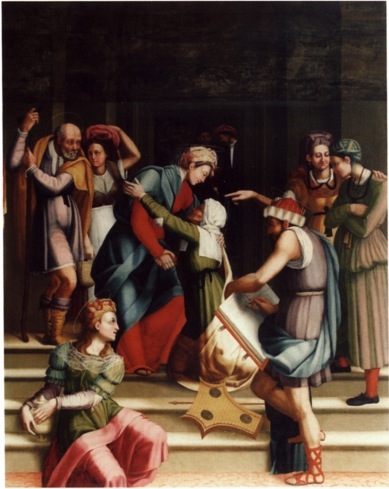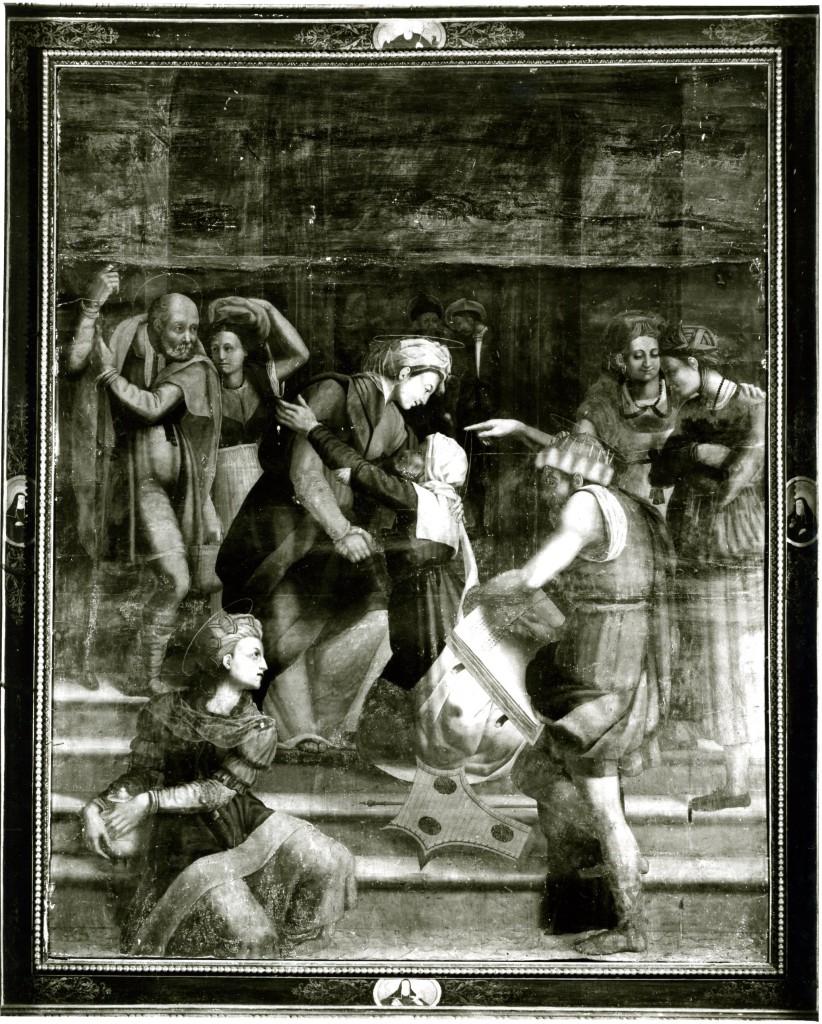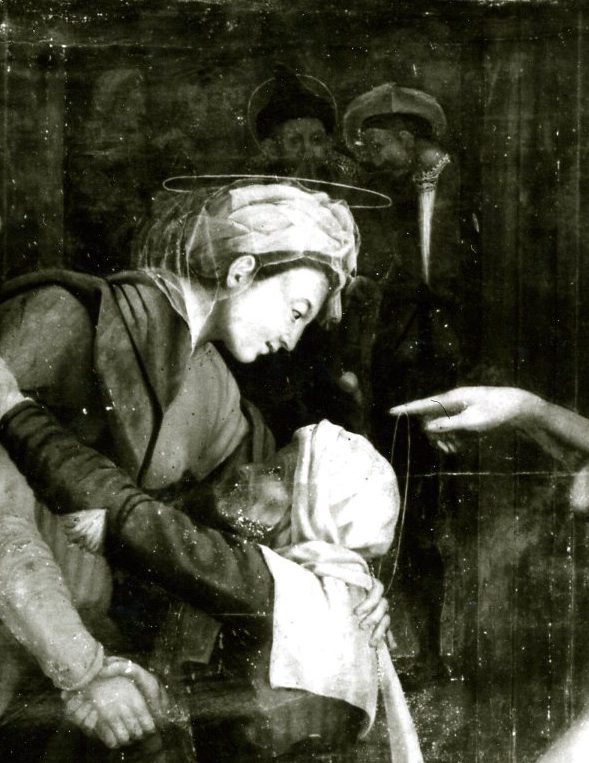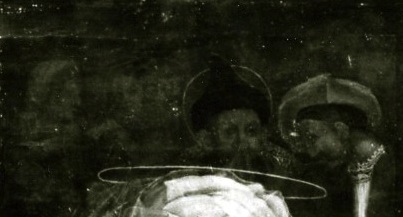Spring, 1524
Drawing made for Giovanni Antonio Lappoli, Arezzo.
Vasari, 1568, III, 383 (Vasari-Milanesi, VI, 9), in the “Life” of Giovanni Antonio Lappoli
“Cessata finalmente alquanto la peste: Cipriano d’Anghiani [Anghiari] huomo ricco in Arezzo, havendo fatta murare di que’giorni nella Badia di santa Fiore in Arezzo una cappella con ornamenti, e colonne di pietra serena, allogò la tavola a Giovan’Antonio per prezzo di scudi cento. Passandro intanto per Arezzo il Rosso, che se n’andara a Roma, e alloggiando con Giovan’Antonio suo amicissimo, intesa l’opera, che havera tolta a fare, gli fece, come volle il Lappoli, uno schizzetto, tutto d’ignudi molto bello: per che messo Giovan’Antonio mano all’opera, imitando il disegno del Rosso, fece nella detta tavola la visitazione di S. Lisabetta, e nel mezzo tondo di sopra un Dio padre con certi putti, ritraendo i panni e tutto il resto di naturale. E condottola a fine ne fu molto lodato, e comendato; e massimamente per alcune teste ritratte di naturale, fatta con buona maniera, e molto utile.”
This passage appears in Vasari’s “Life” of Lappoli following upon the account of his return to Arezzo to escape the plague of 1523 in Florence.1 Rosso is most likely to have stopped in Arezzo in the spring of 1524 on his way to Rome. The painting was completed by 22 March 1525 (see Franklin, 1994, below).
The Visitation that Lappoli made from Rosso’s drawing has always been identified with the altarpiece on the first altar at the right of the entrance of the Badia di Sante Flora e Lucilla in Arezzo (Fig.Lappoli, Visitation and Fig.Lappoli,Visitation,detail).2 Compositionally the painting resembles Rosso’s Sposalizio of 1523 in San Lorenzo (Fig.P.13a), but there are no direct figural similarities that would suggest that Lappoli used that painting independently as the inspiration for his altarpiece. Although the painting in the Badia is neither signed nor dated it is reasonable to assume that it is Lappoli’s and the one that Vasari refers to, and this conclusion has been generally accepted (Barocchi, 1950, 73, n. 1, 243; Carroll, 1967, 297-299, 303, Fig. 1; Freedberg, 1971, 320; 1975, 464; Maetzke, in Giorgio Vasari, 1981, 325, 326, no. 4 and under no. 5; and Fig. 238; Rudolph, 1982, 122; M.G. Sassoli, in Pittura. Cinquecento, 1987, I, 362; Carroll, 1987, 21, 34, n. 55); Franklin, 1994, 105, 106, 107, Pl. 76, Rosso’s “nude sketches” done probably early in 1524, the altarpiece completed by 22 March 1525, according to an unpublished document recording the assessment of it; Franklin states that the picture shows the Visitation with St. Joseph, the Magdalen, and King David; Casciu, 1994, 21, Fig. 21, 22, no. 4, the heads by Lappoli recalling those in Pontormo’s Visitation at the Annunziata in Florence; Costamagna, 1994, 321, under A 113; Haitovsky, 1994, 120, Fig. 13, as designed by Rosso in Arezzo in 1523.3
Vasari says that the drawing that Rosso made for Lappoli was a small sketch of nude figures from which the Aretine painter executed his altarpiece, adding himself the draperies and all else, including some of the heads, studied from nature. Although there is no surviving compositional sketch of this kind by Rosso, Vasari’s report can be believed as it is very likely that he had actually seen the drawing in Arezzo. The soft draperies in Lappoli’s painting are quite unlike the faceted folds in Rosso’s paintings and would be Lappoli’s additions, although it is possible that Rosso gave various headdresses to his nude figures.4
From Vasari’s remarks it is not clear if Rosso included in his drawing the God the Father with angels that Lappoli executed in the now lost lunette that once was above his altarpiece. He may not have, leaving the design of that part to Lappoli as later a lunette by Raffaellino del Colle surmounted Rosso’s Pietà in Borgo Sansepolcro (P.19). Lappoli’s painting in the Badia is rectangular in shape; the upper fourth of it is occupied only by architecture. It is possible that Rosso’s drawing showed the scene to just above the level of the figures’ heads. This would be more in keeping with what appears in the Sposalizio and in the Dei Altarpiece.5
Behind the Virgin are six figures (Fig.Lappoli, Visitation, detail). The two foremost men may be the portraits by Lappoli that Vasari says were highly praised. The man wearing the red hat and shirt with a lace collar is probably Cipriano d’Anghiari, who commissioned the picture (Fig.Visitation, Cipriano). To the left of him the old man with a halo would be Zacharius. The other four in shadow may also be portraits, the first and third women, the other two bearded men. Farther back behind Zacharias and Cipriano may be other heads peering in from doorways.
2 Brizi, 1838, 105. The Biblioteca della Città di Arezzo has manuscript references to this altarpiece, some of which could date earlier, but these may be wholly based on Vasari’s remarks rather than upon actual knowledge of the painting itself (as is also almost certainly the case with Albergotti’s mid-nineteenth century comments mentioned in Carroll, 1967, 297, n. 5).
3 Salmi, 1971, 135, n. 24, recognized the painting as Lappoli’s but made no mention of Rosso. Instead he saw the painting as derived from Pontormo’s painting at Carmignano. As this painting dates later it is possible that Salmi meant Pontormo’s Visitation at SS. Annunziata, which resembles Lappoli’s painting to the extent that it shows the central theme at the top of a small flight of steps. Otherwise it resembles Rosso’s Sposalizio more, which also has a flight of stairs, but also, as in Lappoli’s painting, a dark building in the background that recedes in planes parallel to the picture plane, and two figures in the foreground that are additions to the narrative. Vasari states that after the completion of the Visitation and after the plague had passed in Rome Lappoli left for Rome to which Perino and Rosso had already returned. In the summer of 1524 Rosso was in Cerveteri to escape the plague (see Cellini-Ferrero, 1971, 121-122), but was back in Rome in the autumn to work on the Cesi Chapel commission (see P.17). Hence, Lappoli could have gone to Rome late in 1524 when the Visitation was completed.
4 Maetzke, in Giorgio Vasari, 1981, 326, states that the picture so closely resembles Rosso’s Sposalizio that Rosso must also have given Lappoli a finished drawing for the composition. But Lappoli could have studied Rosso’s painting in Florence before the time that Rosso came to Arezzo. The open book with a text recalls the book held by St. Apollonia in the Sposalizio although its text is not legible except for Rosso’s name. On a nude figure with a somewhat elaborate coiffure of beads and ribbons, see Rosso’s Standing Nude Woman (Fig.D.5). On the Visitation see also Forlani Tempesti, 1992, 94, 97, Fig. 10.
5 According to Maetzke, see above, the painting, oil on panel, measures 310 x 222; I measured it as 247 wide (sight). The varnish of the upper fourth of the painting has become blanched. The two texts inscribed on the left page of the open book held by King David are: IVSTITIA ANTE / EVM. AMBVLA[BI]T / ET PONET. IN VIA [GR] / ESSV. SVOS, of Vulgate Psalm 84:14 (Justice shall walk before him: and shall set his steps in the way); and: ILLVC. PRODUCAM. / CORNV. DAVID [PA] / RAVILUCERNAM / CRISTO. MEO, of Vulgate Psalm 131:17 (There I will bring forth a horn to David: I have prepared a lamp for my anointed). Lappoli’s lunette would have occupied an area that probably was separated from the Visitation by a horizontal moulding of the frame that surrounded and joined the two parts of this altarpiece. I have wondered if the blanched upper part of the present altarpiece is an addition replacing the area where the lost lunette would have been. The chapel that Cipriano d’Anghiari had built no longer exists and may have been destroyed when Vasari enlarged the Badia in the middle of the sixteenth century. It is not known when the lunette disappeared.
A drawing related to Lappoli’s Visitation is the Meeting at the Golden Gate, Uffizi 6470F (Fig.Florence, 6470F), inscribed in ink at the lower right: Rosso darezzo (pen and ink and wash over traces of black chalk, 28.2 x 21.5; the verso is lightly and evenly blackened with chalk). LITERATURE: Berenson, 1903, no. 2404, as Rosso. Kusenberg, 1931, 152, no. 5, as not by Rosso. Berenson, 1938, no. 2404, as not by Rosso. Barocchi, 1950, 221, as possibly by Salviati. Cheney, 1963, 572, as a drawing that has been attributed to Salviati. Carroll, 1967, 299, n. 11, Fig. 4, as perhaps by Lappoli, and as derived from Lappoli’s Visitation, or from Rosso’s drawing for it, or from another drawing that Rosso brought to or made in Arezzo in 1524. Mortari, 1992, 190, no. 112, with Fig., as possibly a copy after Rosso. Franklin, 1994, 249, Pl. 198, as a copy after Rosso, presumably by some local Aretine artist, of a drawing by Rosso that may have been for a scene on the vault of S. Maria delle Lagrime [see Preface to D.31-34].
It still seems to me that the drawing could be by Lappoli, who as a draughtsman we know very little, and derived from his Visitation or from another drawing by Rosso. But it would need further evidence to make it meaningful in a consideration of Rosso’s art. Forlani Tempesti, 1992, 97-98, 101, n. 17, Fig. 9, as not by Lappoli, although by a follower of Rosso; she also pointed out that the collector’s mark (Lugt 2712) on the drawing does not indicate a provenance from the collection of Cardinal Leopoldo de’Medici but instead from a somewhat later collection. I see no reason to connect this drawing to the Lagrime project.




